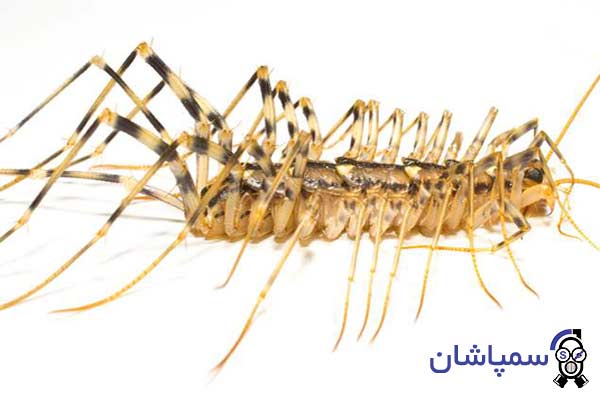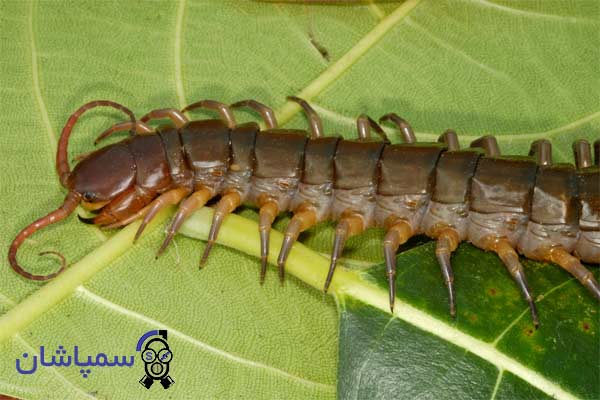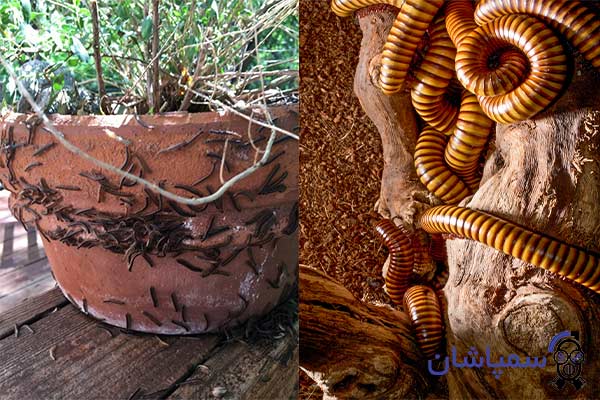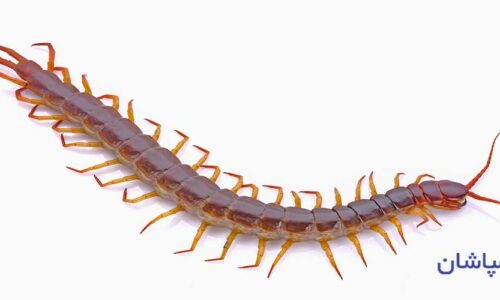The millipede insect is sometimes called a millipede and a hundred feet because of the large number of pairs of legs it has. They are widely distributed around the world. Millipedes are rarely seen by humans due to the nocturnal activity of these pests and the speed at which they move. Most millipedes live more than a year and up to six years. In this article, we describe some of the features and specifications of this insect:
Appearance profile of millipede
Color: dark yellowish yellow
Number of legs: 15 to 177 pairs
Shape: long, smooth, cream-like
Size: 4 to 152 mm in length
Area: Worldwide

What do millipedes look like?
House millipedes are easily identified by their long legs and pairs. They can actually have from 15 to 177 pairs of legs with one pair in each section, depending on the species. Surprisingly, these creatures always have a strange number of pairs of legs.
In general, the body of a millipede is usually dark brown in color, and sometimes with darker stripes or darker markings on it. The millipede head has a pair of long, delicate tentacles covered with thick hair. They have small mouths and large claw-like structures that contain a venom gland. In fact, some millipedes have compound eyes that contain about 200 units of light, while others have a simple eye on each side, or some do not even have eyes.
There are two types of millipede insects with different appearance characteristics. Common species of this insect, which are domestic and are known as the Scutigera house. These millipedes are about 25 to 38 mm long and their body is yellow with three black stripes and they have 15 pairs of legs. The last tentacles and pairs of legs are longer than the body. The largest millipede is the Scolopendra and may be up to 15 cm long. The legs and tentacles of this type are shorter than ordinary millipedes.
Signs of a millipede
There is usually no direct sign of a millipede other than seeing the pest itself. These insects are mostly found in pots and gardens and are very active at night.
Ways to destroy millipedes
The most effective way to prevent invasion and destroy millipedes is to reduce the amount of moisture in and around the house. Collect leaf fragments and remnants of branches and grasses, rocks and anything that creates a conducive environment for them to hide. If there is firewood, keep it in a dry and suitable place. Providing adequate ventilation in the basement and attic space to remove moisture as well as closing the seams and cracks in the house is one of the main ways to prevent millipedes from entering the house.
If you encounter a millipede infestation at home, you can use the methods mentioned above to eliminate them over a period of several weeks. But if you see a large number of these insects, you can contact the spraying experts to spray your house.

Poison to kill millipedes
With years of experience in combating pests that are seen at home and cause harassment, the sprayer collection has created a special poison to kill millipedes by combining several strong poisons, and you can use millipede poison with instructions for its use. Prepare and get rid of these insects forever.
Is a millipede bite poisonous?
Millipedes can bite humans when they feel threatened, and millipede stings can damage human skin and cause swelling and pain in that area, such as bee stings. Some larger species of this insect have more painful bites and should be carefully controlled. The bites of some species of millipedes are also poisonous, but not to the extent that they endanger people’s lives, and if you are bitten, be sure to see a doctor.
Millipede habits
Millipedes usually take care of themselves in protected conditions in the cold season and start laying eggs during the summer, usually on the ground. Female millipedes produce up to 35 eggs in a period of several days.
Millipedes are found in areas with high humidity, such as rotten tree trunks, under rocks, garbage cans, and places with lots of leaves and grass. They are found in basements, bathrooms, and especially pots.
All millipedes have very poor eyesight and trace their prey through their sense of touch and smell. Most millipedes are carnivores and feed on prey such as mosquitoes, flies, spiders in pots and humid environments, as well as wood and plants.
Causes and benefits of millipedes in pots
There is another type of millipede, scientifically called Millipedes, which, unlike the common millipedes we have described, is herbivorous and is found in abundance in pots and is confused with the common type of millipede due to its close resemblance and large number of legs. These insects feed on rotten plant components, including wood and cellulosic materials. Reproduction of this type of millipede is high and is dangerous due to the secretion of a foul-smelling and toxic substance from there that causes blisters on human skin.

These millipedes are very useful in composting operations, and while they help break down excess soil contents, they also feed on plants and can kill buds. The benefits of millipedes in pots are when their number is controlled, but in general they are more suitable for large gardens and pots that have more soil and cause more soil fertility.
